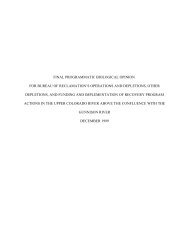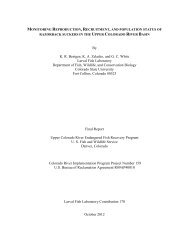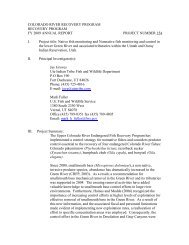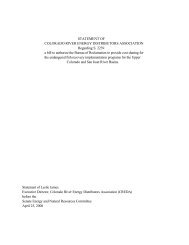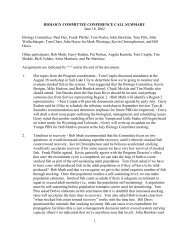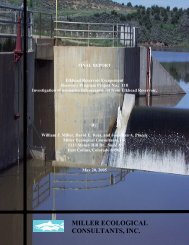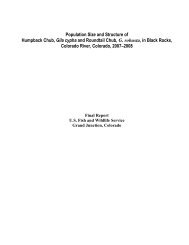riprap - Upper Colorado River Endangered Fish Recovery Program
riprap - Upper Colorado River Endangered Fish Recovery Program
riprap - Upper Colorado River Endangered Fish Recovery Program
You also want an ePaper? Increase the reach of your titles
YUMPU automatically turns print PDFs into web optimized ePapers that Google loves.
2.4 IV. CONSERVE GENETIC INTEGRITY AND AUGMENT OR RESTOREPOPULATIONSSpecies recovery depends on protecting and managing species genetic resources. Thisis a complex activity that includes: determining the genetic diversity of the endangeredfishes; protecting species in refugia; planning, developing, and operating propagationfacilities; propagating fish for augmentation or restoration, research, and informationand education; and planning, implementing, and evaluating augmentation or restorationof species. Stocking is only an interim tool in the <strong>Recovery</strong> <strong>Program</strong> because recovery,by definition, implies that the populations will be self-sustaining in the wild. Thesuccess of augmentation and restoration stocking is dependent on prior or concurrentimplementation of other recovery actions such as flow protection, habitat restoration,and management of nonnative fishes. This dependency is reflected in the schedule ofsubbasin-specific actions in Section 4.0.The <strong>Recovery</strong> <strong>Program</strong> has recognized the need to increase augmentation andrestoration stocking (primarily for razorback sucker and bonytail), both for recovery ofthe species and to establish fish in the system to be able to demonstrate that habitatand instream flow activities are having an effect on endangered fish recovery. The<strong>Recovery</strong> <strong>Program</strong> is implementing an integrated stocking plan developed for bonytail,<strong>Colorado</strong> pikeminnow (stocking on hold), and razorback sucker. The <strong>Recovery</strong><strong>Program</strong> continues to evaluate the need for implementing an integrated stocking planfor humpback chub especially for restoring specific stocks thought to be too low foradequate natural recruitment. Humpback chub is not currently being stocked; however,augmentation of existing small populations may become necessary and some fish havebeen brought into captivity.An ad hoc group reviewed the population and known genetics information from all thehumpback populations and concluded that the <strong>Recovery</strong> <strong>Program</strong> should: 1) use adecision tree to guide choices in creating a refuge population and potentially stockingfish into the wild; and 2) genetically test, and if appropriate, use Westwater Canyon andBlack Rocks humpback chub to initially provide a refuge for <strong>Upper</strong> <strong>Colorado</strong> <strong>River</strong>Basin genetics, because they genetically represent most populations in the upper basin.Studies to confirm genetic diversity have been vital to genetics management of theendangered fishes. Species are being protected in refugia to develop broodstocks andguard against catastrophe. Representatives of species thought to be in immediatedanger of extinction are brought into refugia immediately. Refugia populations ofspecies are developed using paired breeding matrices to maximize genetic variabilityand maintain genetic integrity.Most of this work is included under the General <strong>Recovery</strong> <strong>Program</strong> Support Action Planbecause it applies <strong>Upper</strong> Basin wide. Subbasin-specific activities of augmenting orrestoring species are placed under the subbasin Action Plans. Augmentation orrestoration plans are being implemented, fish produced, and river reaches restored and11



